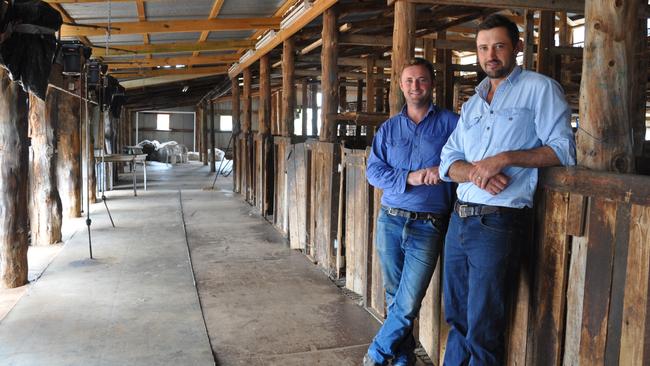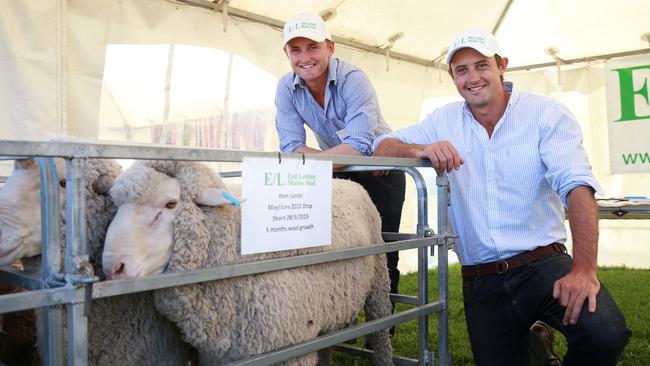Northern move proves seismic for Tom and Marcus Hooke
A move to the Riverina in NSW to begin new ventures is reaping dividends for these sixth-generation Victorian sheep producers.

A timely move north to the Hay Plains of southern NSW has expanded the horizons for a sixth generation of sheep producers in the Hooke family.
Tom Hooke, 34, and his brother Marcus, 32, with their parents, Dianne and Bill, have struck a market of high prices and great seasonal conditions at full production, just a decade after leaving Bill’s family stronghold at Serpentine, taking their well-established East Loddon Merino Stud with them, to begin new ventures.
After the 2018 drought and last year’s bumper conditions, the family is quickly learning what it takes to run successful stud and commercial Merino enterprises on land that can be as cruel as it can be kind.
Their secret is to maximise a quick turnover of high-value commercial ewes and selling them on-property mostly to repeat buyers who want to boost wool and meat production in their own flocks.
Behind this is a focus on producing the best sheep for combined meat and wool production that money can buy.
It has taken years of improvement, which they had a good headstart on thanks to Bill’s foresight to engage Merino industry giant Dr Jim Watts to class their East Loddon stud sheep which he did until his death in 2019.
It means the stud and commercial flocks now bear Dr Watts’s revolutionary soft rolling skins.
The great festoonery of wrinkles for which Merinos were once famous, but which made them so vulnerable to fly strike are long gone. With careful gene selection for soft rolling skins and fleece fibre alignment, fleeces are no longer moisture traps.
Fly strike and fleece rot, which beggared producers for a good century, are also largely banished from the Hookes’ flocks.
“We’ve been through a serious process of getting the skin right and by that I mean developing a thin loose pliable skin on our sheep that’s without body wrinkle,” Tom says. “It’s not enough to just remove the big neck folds. We wanted the right skin and good fleece weights of long, highly aligned fibres.”
MARKET WIN
THE investment has paid off. This summer just gone, one of the steamiest the Hay Plains has seen for some time, the Hookes successfully extended non-mulesing across their entire stud and commercial flock for the first time, making their wool attractive in a market that is increasingly sensitive about ethical production.
“Our stud flock hasn’t been mulesed for 15 years and we stopped mulesing our commercial flock 100 per cent this year,” Tom said.
“If ever there was a year to test how that would go it was this year because there was so much moisture about.”
Using Australian Sheep Breeding Values to benchmark for quality, they join 1000 stud ewes annually, feeding the improved genetics in their stud stock into their commercial flock.
Joining and lambing is tightly timed to ensure ewes lamb on to the famous flat pastoral plains when its native perennial pastures, now greatly dwindled after generating wealth for generations of pastoralists, are at peak feed quality.
“Rams bred in the stud flock are classed up, and a top line are offered at our annual on-property ram sale,” Marcus said.
“Further grade rams are offered privately later. Some stud and flock rams are of course retained.
“The latter are joined with our 10,000 commercial ewes. We’ll keep some for the commercial flock each year and depending on the quality, we’ll also keep four or five stud quality rams for the stud.
“We also purchase AI semen from other studs most years to bring in genetics for improving traits. For example if we need more muscle and fat and we don’t have rams coming through we’ll go and look in the industry for semen from rams that have that trait.”
Ten years ago the Hookes began using rams benchmarked for fat and muscle to increase what they call do-ability or robustness, traits that are key for the modern Merino to thrive.
LAMBING TEST
EWES that don’t get into lamb, or don’t raise a lamb, after being joined to a commercial Merino ram are removed from the Merino breeding flock then either joined to a White Suffolk ram or sold.
“The commercial flock is where we make money,” Tom said. “And that’s where our clients make money so we run our stud-drop ewe lambs with our commercial flock.”
Marcus echoes this approach.
“There’s no point pampering our stud sheep. We want to test them out and identify their faults so we can fix them,” he said.
The aim is to boost lamb survival and growth rates so that commercial lambs can be sold at killable weights (45kg) at or soon after weaning.
Their sheep cut about 7.3kg of 19-micron wool annually. They’re shorn at two seven-month intervals and then 10 months later to achieve staple lengths of 70-100mm. Shearing is timed to avoid stressing ewes around joining and lambing. Now costing an average $10 a head, shearing, alongside grain for feed, is one of their biggest costs. Their freshly acquired Responsible Wool Standards accreditation, which audits everything from shearer to dog welfare, compensates to some degree with their wool agent estimating it earned them an extra 30-100c/kg with some exciting relationships developing in regard to direct supply and forward contracts.
This coming spring, the Hookes estimate, they will turn off more than 5000 wether lambs, about 1000 Merino-White Suffolk crossbred lambs, about 2000 surplus young ewes and about 3000 5½-year-old ewes from their commercial flock. It is the first year they will not carry the older stock over, a sign they are meeting targets to reduce the flock’s average age. It also means their older stock is sold when still young enough to produce another lamb, increasing their value at sale.
Last year their just-weaned wethers topped AuctionsPlus sales.
“Ninety-seven per cent of wether lambs sold within a few weeks of weaning, weighing 43kg on average and we classed out the other three per cent,” Tom said. “Some went to growers to grow out who’ll get a wool clip from them and sell them before they cut their teeth. Some went straight to the meatworks.”

MAXIMUM EFFECT
THE Hookes’ commercial enterprise is all about running the maximum amount of breeding ewes and “just going for numbers, high weaning percentages and high turnover”.
“We produce high numbers and get them up to weight quickly and turn them off quickly and in good condition,” Tom said.
“The genetics enables us to do that. It’s the best money we can make in our environment.”
Getting the weaners off early means they don’t have to be carried over summer and feed is preserved for the ewes. Inputs are low to match the rainfall (370mm annual average in nearby Hay).
About 200 Angus cows are kept “to take out the rougher feed in paddocks that sheep wouldn’t eat”, with 80 to 100 steers sold annually at feedlot weights of about 340kg.
All this entails a lot of juggling, something the extended family is geared for.
With degrees in agricultural science and business, their parents’ acumen and their father’s sheep experience, the younger generation of Hookes is primed to run a successful agricultural business.
Their post-university experience on other farms has also helped. Marcus was a jackaroo in northern Australia and Tom worked at a cropping enterprise in Canada as well as in Meat and Livestock Australia’s Sheep Genetics office where he learnt about how to use and apply ASBVs.
Tom especially, is emphatic that he returned to farming not because he grew up on a farm, but because he saw the opportunity to grow a great business.
“The last thing I wanted to do was go farming because I like sheep and because Dad’s a farmer,” he said. “That didn’t sit well with me. I saw it as a good opportunity to run a business in which you make your own luck, reap the rewards and suffer the downfalls.”
All up, the Hookes run about 25,900ha — 15,378ha on Warwillah at Wanganella where Tom and his wife, Sarah, live today, 8094ha on Nyangay at Booroorban, where Marcus and his wife, Cass, live, and 2428ha at Elmsleigh, where Dianne and Bill live.
The roughly adjoining properties of sandier red to grey cracking soils each have a central bore that pumps water at 700 ppm from about 100m below the surface into tanks that then feed out via buried pipes to troughs. It takes 1½ days to do a bore run across Warwillah and Nyangay.
MOB MENTALITY
THE family is keen to explore how they might use what’s broadly termed regenerative agriculture across their broad acreage, an approach used mostly on smaller holdings, not big pastoral runs.
Tom is studying this as part of his Nuffield Scholarship this year. He and Marcus see value in running stock in larger mobs and intensively grazing where suitable for short periods and then spelling that country to allow perennial pastures to recover and roots to deepen and consolidate.
They aim to improve ground cover and soil health to sustain their natural feed stocks long term and “because it’s good for the country and therefore good for business”.
Boosting stored carbon is another opportunity the brothers are keen to investigate. “We don’t fertilise, we don’t renovate pastures, we don’t use any mechanical intervention,” they said “The only thing we do is graze and our greatest ability to influence the soil health is through our grazing system.”
The test will be in consecutively dry years, when pastoralists traditionally have to gamble on reducing stock numbers, destocking completely and trying to buy back in when seasons turn or trying to carry stock through on usually expensive feed.
They have begun reducing 1618-2832ha paddocks to about 405ha. They’ve also invested in 60sq metre containment yards that can hold 500 ewes each on Warwillah, enough to hold about 7000 sheep all up. More are planned for Nyangay.
In the dry year of 2018, about 5000 sheep were fed in small sacrifice paddocks. The other 5000 sheep were rotated around the properties and fed 200g a day of grain, to ease grazing pressure on the dry soils.
“At the start of 2018 we thought we were heading into a normal year but as we got into lambing it didn’t rain,” Tom said. “We were lucky because we were already feeding the most vulnerable stock, the twin bearers and still managed to mark 110 per cent overall.”
Future use of the new containment yards and greater forward planning will make management much simpler.
Reducing paddock size entails investing in fencing and more water points, but with smaller paddocks they’ll also be able to manage twin-bearing ewes in smaller mobs, maximise ewe care and lamb survival.
In 2018 the Hookes paid big for grain. Barley was more than $400 a tonne, twice its current cost, so on-farm grain storage is another prospect.
There’s no doubt the Hookes have had a great run to date.
“We walked into a pretty good set-up with Jim Watts’s influence now well established in our flocks,” Marcus said.
For that, the brothers thank their father Bill. They know there are droughts to come. They’re planning for those.
And as Tom says “there is no point running a business assuming it’s going to fail”. “We acknowledge the risks. We also have to be ready to make the money when the rain comes,” he said.
MORE
WOOL PRODUCTION FORECAST LOOKS GOOD FOR PRODUCERS
SUSTAINABILITY KEY FOCUS FOR SHEEP INDUSTRY
AUSTRALIA’S BEST AND MOST INNOVATIVE FOOD PRODUCERS BY STATE


